The Vatican Museums are among the top tourist attractions in Rome, renowned worldwide for their extensive collections. Situated inside the Vatican walls, the museums house a plethora of artworks, sculptures, frescoes, and ancient and modern paintings, including the magnificent Sistine Chapel. Visiting the Vatican Museums is an exceptional and captivating experience. In this article, I provide tips on how to make the most of it.
Table of Contents
Navigating the Vatican Museums: What to Include in Your Sightseeing
The Vatican Museums are among the most visited places in the world. The museums are so vast that seeing everything in one visit is impossible. Please note that certain collections may not be accessible to the general public. Therefore, it is essential to plan your visit and invest in the guidance of an expert. A guide can help you navigate the museums that make up the complex and provide insights into the history and architecture of the Vatican palaces. For my readers, there is an exclusive discount available for guided tours. Please read till the end to find out more.
PLAN YOUR TRIP TO VATICAN CITY
Vatican City is an independent state within Rome. For this reason, to save on entrance fees, you need to buy an integrated pass such as the Go City Explorer Pass, which includes entrance to the Vatican Museums with the Sistine Chapel. In alternative you can choose the Vatican City Card dedicated to the Vatican Museums and includes the hop-on hop-off sightseeing bus.
To stay connected in Italy, remember to buy an Airalo eSim online, with data and phone coverage for your trip to Rome.
When planning your itinerary, certain must-see attractions draw in over five million international tourists annually. These include the Sistine Chapel, renowned for its frescoes, including Michelangelo’s iconic Last Judgement. The Raphael Rooms, a collection of rooms adorned with frescoes by the famous Renaissance painter. And the Gallery of the Geographical Maps, decorated with ancient and intricate maps of Italy.
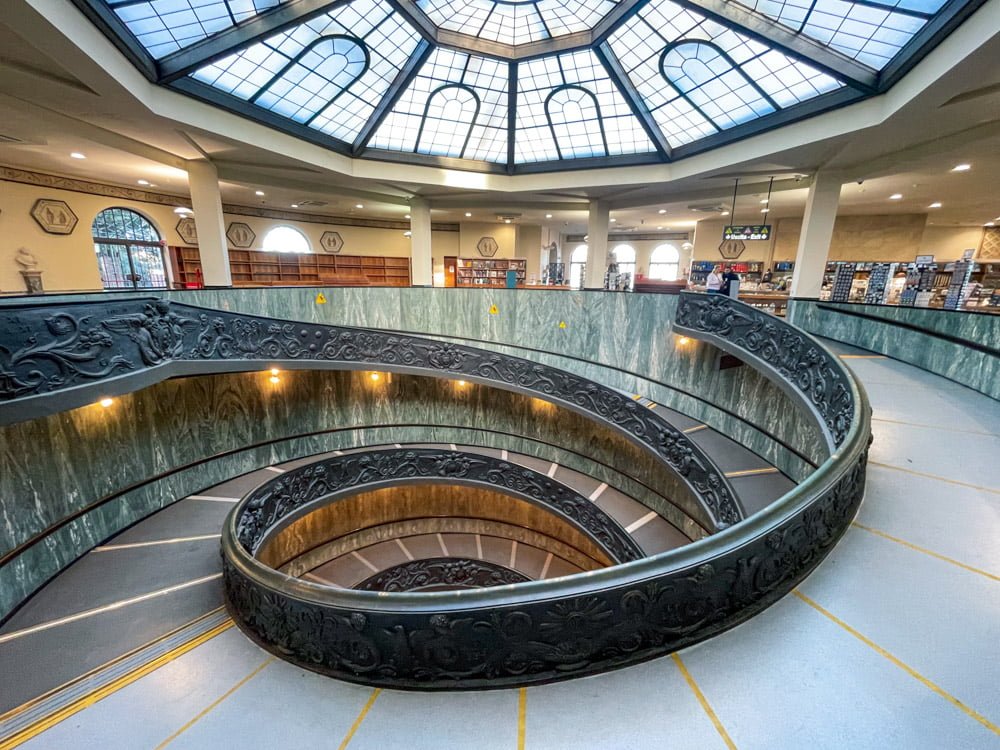
The Sistine Chapel
The Sistine Chapel is undoubtedly the most renowned and highly frequented section of the Vatican Museums. Famous for its ceiling frescoes painted by Michelangelo, it is regarded as one of the most significant works of Western art. Visiting the Sistine Chapel is an extraordinary experience that will leave you amazed.
The Sistine Chapel was named after Pope Sixtus IV, who commissioned its construction. However, it underwent significant restorations and renovations that altered its appearance. Michelangelo painted his renowned ceiling frescoes because the original star ceiling needed redecoration. Additionally, Michelangelo’s The Last Judgment, painted on the altar wall, replaced some frescoes by Florentine artists on the walls depicting the New and Old Testament.
The Sistine Chapel is home to many fascinating details, including the famous depiction of the Creation of Adam. In this painting, the fingers of God and man almost touch but do not quite make contact. Of respect for the chapel’s religious significance, guides cannot speak inside. However, visitors can learn about the details of the frescoes in one of the Vatican Museums courtyards, where enlarged versions of the most intriguing aspects are on display.
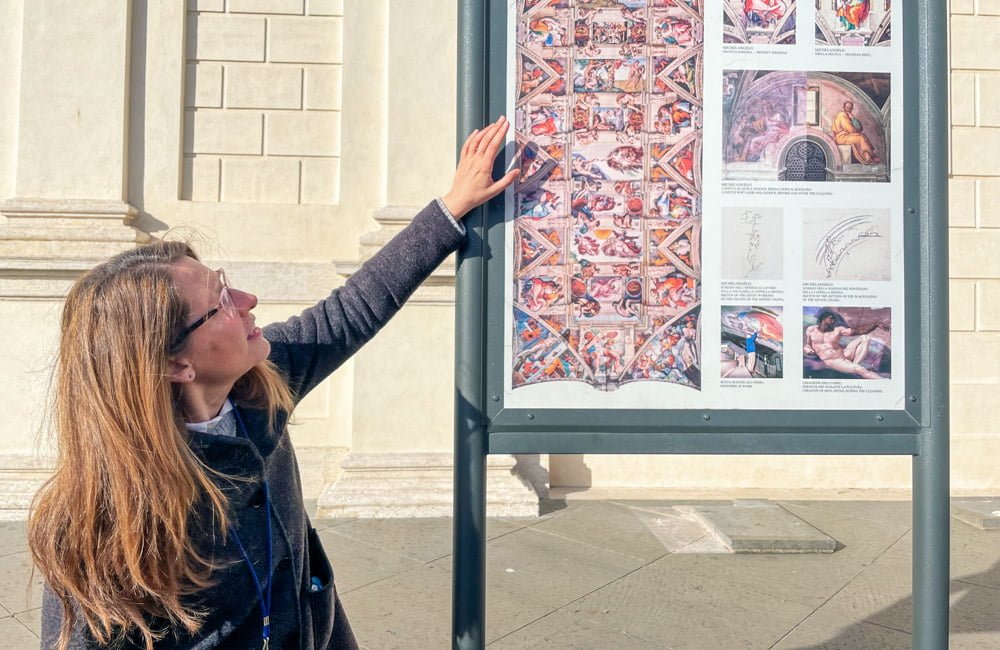
Censorship and controversial frescoes in the Sistine Chapel
Thanks to my guide, Claudia Pettinari, I learned the stories behind the nude depictions of saints and mythological characters in frescoes later covered up. Contact Claudia for a tour of Rome and mention this blog post.
Michelangelo created these drawings on the altar wall. However, later, popes deemed them too explicit and indecent, so cloth drapes covered the most explicit nudity. Michelangelo inserted portraits into some figures, such as Minos, which portrays the face of Cardinal Biagio da Cesena at the bottom of Inferno. Cardinal Biagio da Cesena had called Michelangelo’s work obscene.
In the Last Judgement scene representing St Bartholomew, there is a strange depiction of the saint holding his skinned skin. Some believe it to be an ironic portrait of Pietro Aretino, holding up a self-portrait of Michelangelo, who was criticised unfairly. However, if you interpret it from a religious perspective, the saint is holding his flayed skin, referring to the apostle martyred in this manner.
Michelangelo’s sense of irony is apparent in the Creation of the Plants scene in the ceiling. The Creator’s figure, depicted from behind, is wearing a pink tunic that accentuates his posterior, and it is rumoured that the figure was created due to a quarrel with Pope Julius II. In this way, the painter forever turned his back to his patron, who was intent on performing Mass.
The Raphael Rooms
The Raphael Rooms are a precious collection located within the Vatican Museums. Painted by the renowned artist Raphael Sanzio and his students between 1508 and 1524, the rooms on the second floor of the Apostolic Palace are a masterpiece of Italian Renaissance art.
The first room you enter is the Stanza di Costantino, the largest room in the building. Frescoes on the walls depict the story of Constantine’s vision of Christ in a dream, which he had before the battle at the Ponte Milvio against Maxentius.
The Stanza della Segnatura is the most crucial room in the Vatican Museums. Inside, Raphael painted four frescoes that symbolise the liberal arts: theology, philosophy, jurisprudence, and poetry. The Vatican Museums ticket features a detail of one of these frescoes, and you’ll see various groups of tourists taking pictures of the ticket in front of the fresco. I also took a picture of the ticket in front of the fresco, which you can see on the cover.
The Stanza di Eliodoro showcases the miracles of God. Notable frescoes in this room include the Liberation of St Peter from Prison and Pope Leo IV’s victory over the sacking of Rome by the Saracens. Additionally, the Stanza dell’Incendio di Borgo portrays the miraculous event of the suppression of a fire that threatened the city of Rome during the pontificate of Leo IV. This room is a form of propaganda, reminding us that only faith in the Catholic Church can lead to salvation.
The Gallery of the Geographical Maps
The Gallery of the Geographical Maps is a popular section of the Vatican Museums. On the walls are several geographical maps of Italy, commissioned by Pope Gregory XIII in 1580. These maps depict the Italian regions and papal possessions of the time, as seen from the perspective of Bologna, his city of origin. Therefore, Emilia Romagna is in the centre, with the northern provinces upright and the southern ones upside down.
The frescoes of geographical maps in the gallery provide a fascinating glimpse into the geography of that era with their unique details. Created in the Renaissance style, they feature numerous scenes of daily life depicted along the margins. Each map is a masterpiece in itself, and together, they form an impressive collection of historical cartography.
The Gallery of the Geographical Maps had two purposes. Firstly, to celebrate the significance of geographical knowledge during the era of the great discoveries. Secondly, to demonstrate to the visitors of the current Pope how expansive the temporal power of the Vatican was.
In fact, on the maps, monasteries are the most significant landmarks. For example, in Piedmont, you can see several small mountain villages because they are home abbeys, but not bigger towns because they were not religious centres.
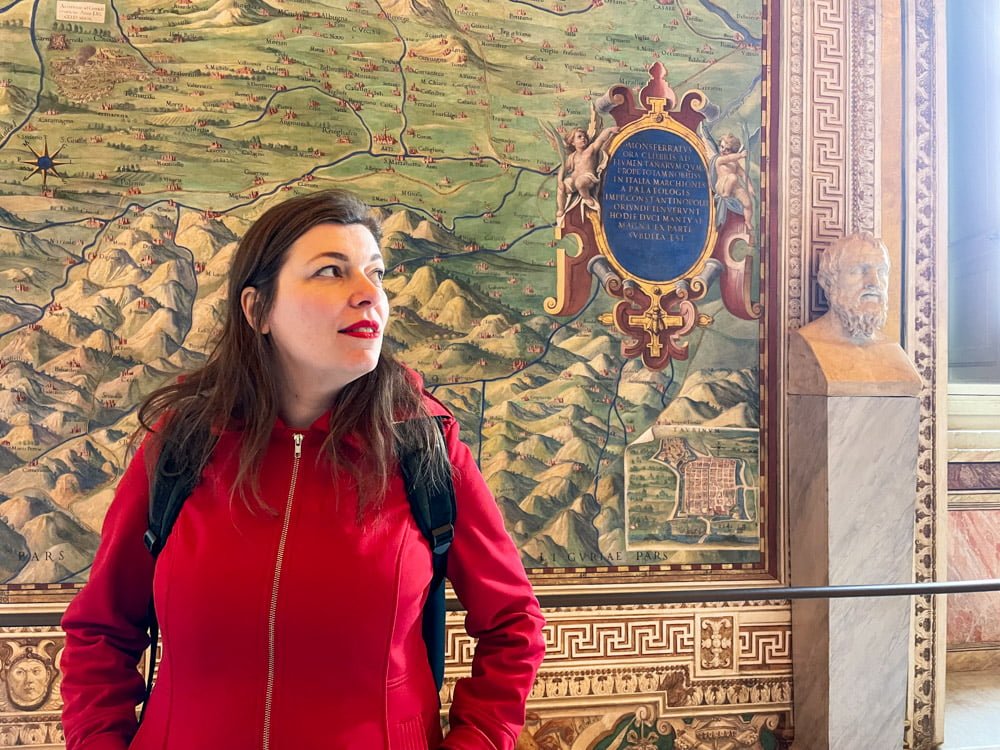
The Tapestry Gallery
The Tapestry Gallery houses a collection of tapestries commissioned by Pope Clement VII from the best Flemish weavers in the 16th century. These tapestries, made of gold and silk threads, showcase the life of Christ and St. Peter and are, once again, a testament to the influence and wealth of the Roman Catholic Church.
Creating tapestries of such impressive dimensions, measuring four meters wide and featuring highly detailed designs, was a costly undertaking. Only the wealthiest rulers of the time had the resources to afford such magnificent works of art.
Modern Art in the Vatican Museums
The Vatican Museums are home to a vast collection of ancient and medieval art and a significant collection of modern art. The collection includes works from renowned artists such as Vincent Van Gogh, Marc Chagall, Salvador Dali, Pablo Picasso and many other notable artists. The Vatican Museum of Contemporary Art, also known as the Collection of Modern and Contemporary Art, established in 1973, showcases an exceptional modern and contemporary art collection.
The Palazzo della Rovere, located behind St. Peter’s Basilica, displays a collection of artworks visitors can view. Although the collection is not extensive, it covers specific themes. Occasionally, contemporary artists temporarily showcase works. During your visit to the Vatican Museums, you can see Arnaldo Pomodoro’s famous bronze sphere in the Courtyard of the Pine Cone.
The Vatican Museums hold a significant collection of modern art that showcases works by renowned artists and the connection between contemporary art and the Christian tradition. Although some contemporary pieces may be challenging to interpret, they offer a valuable opportunity to explore the intersection of art and religion.
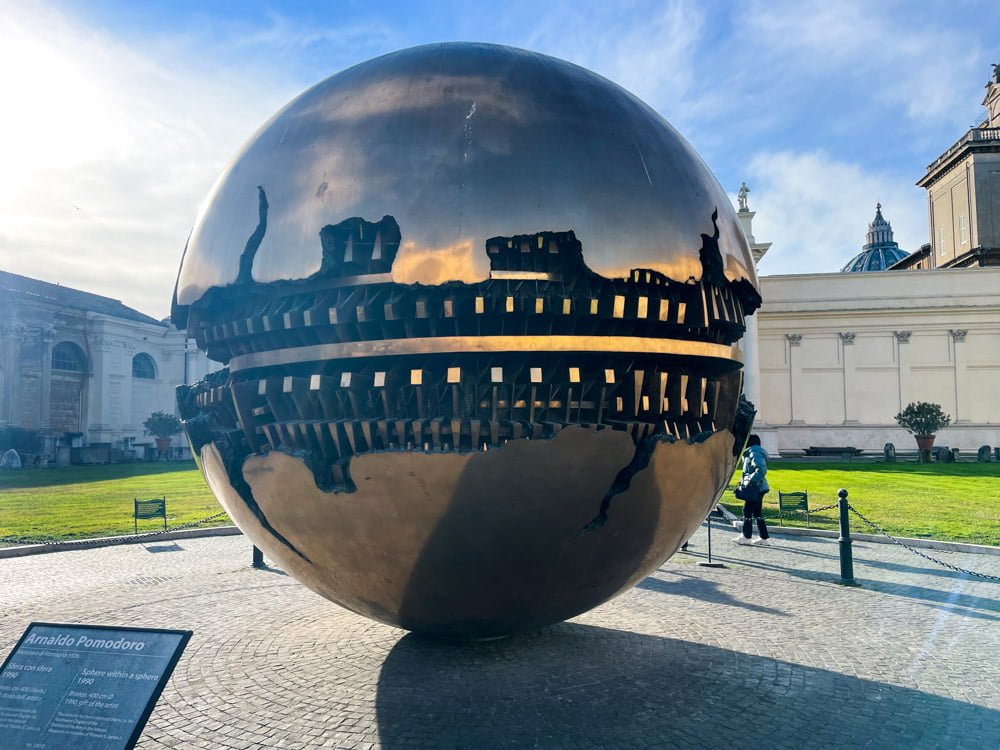
Besides the Vatican Museums: The Vatican Courtyards and Gardens
The Vatican Gardens, created by Pope Nicholas III in 1279, are one of the most extensive historical gardens in the world and cover almost half of the Vatican City State, with an area of 23 hectares. Although the gardens are only accessible by appointment, you can catch glimpses of them while passing through several courtyards while visiting the Vatican Museums.
The Green Area Complex comprises a stunning combination of gardens, parks, labyrinths and caves showcasing various plants and flowers. Due to their exceptional beauty and harmony, the Vatican Gardens became a UNESCO World Heritage Site in 1984. The oldest part of the garden is the Papal Gardens, located behind the Apostolic Palace, which houses numerous fountains and monuments.
While visiting the Vatican Museums, you will come across numerous open-air areas. The Vatican Courtyards, built in different periods, showcase the history of the Papal States through the architecture and display artworks.
The Courtyard of the Pine Cone is the most famous and impressive. Located next to the Vatican Picture Gallery, you can identify it by the enormous bronze pine cone that gives it its name. The pine cone is considered a symbol of eternity because it has never been melted down over the centuries and is said to last as long as Rome.
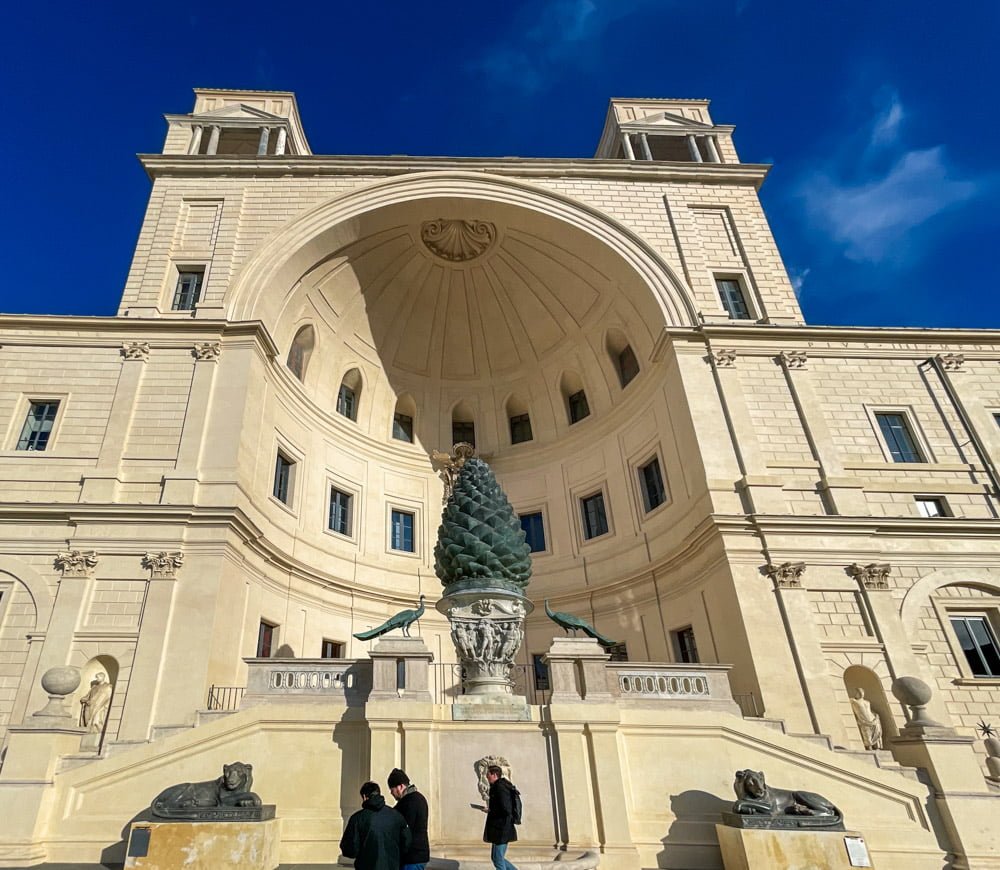
The Octagonal Courtyard is a well-known courtyard that features 18th-century architecture and houses many ancient sculptures, including the famous statue of Laocoon and his sons. The papacy exhibited this sculpture to convey the message that salvation can only come through the faith of the Roman Catholic Church. According to legends, only Aeneas, one of the founders of the Eternal City, was spared from the massacre of Troy.
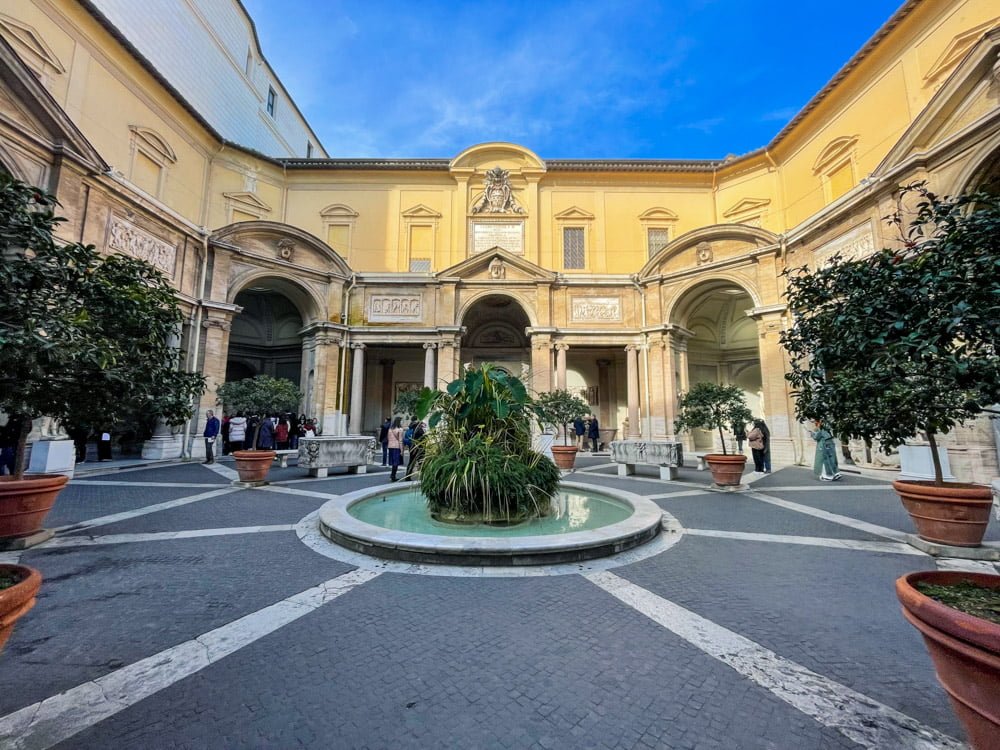
Vatican Museums: Origins and their Journey Through Time
The Vatican Museums are now one of the most famous and visited museums in the world. However, their beginnings as a private collection of the popes can be traced back to Julius II in 1506. During the Renaissance, the buildings that now house the museums were originally the private flats of the pope. The papal collection at that time was relatively small but highly significant, featuring works by renowned artists such as Leonardo da Vinci and Raphael.
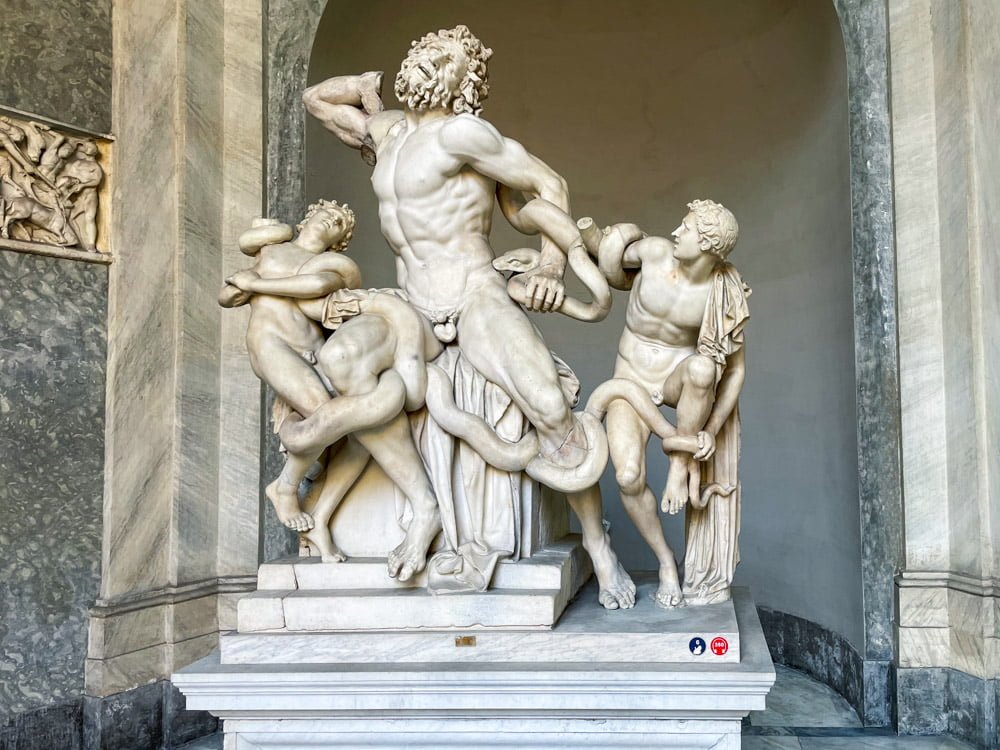
Over many centuries, the collections owned by the Pope grew in size and importance and now consist of over 70,000 works of art. The museum was established gradually with the opening of the Pio-Clementina Collection to the public in 1771 during the reign of Pope Clement XIV. Later, the Vatican Picture Gallery opened in 1822.
The Vatican Museums, as we know them today, were created in 1837 by Pope Gregory XVI when he united different art collections into one museum. As a result, the popes moved out of the museum buildings while the Vatican Museums opened to the public. The museum buildings were then expanded with new wings, courtyards, and corridors.
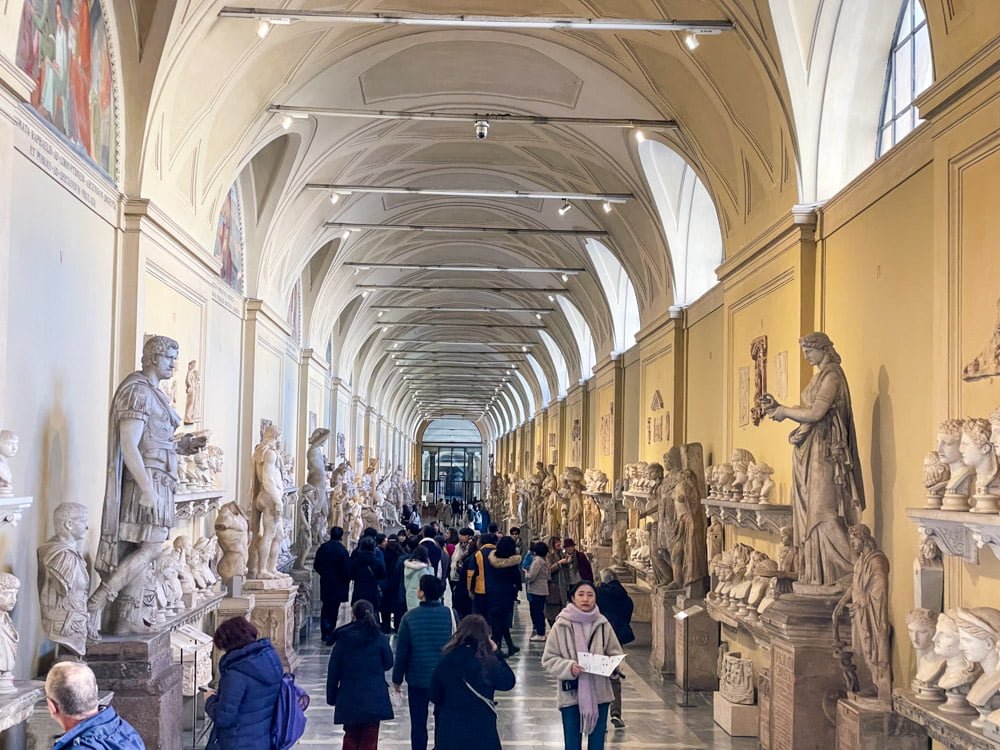
Museums Under the Vatican Museums Umbrella
The Vatican Museums comprise numerous individual museums, making it impossible to visit all of them in one go. Each section has its specialisation and displays a unique collection of art, objects, and sculptures from different cultures and eras.
The list includes: Gregorian Egyptian Museum, Gregorian Etruscan Museum, Pio Clementine Museum, Chiaramonti Museum, Lapidary Gallery, Braccio Nuovo, Profane Gregorian Museum, Profane Lapidary ex Lateranense, Pio Christian Museum, Christian Lapidary, Jewish Lapidary, Art Gallery, Anima Mundi Ethnological Museum, Pavilion of the Carriages, Christian Museum, Profane Museum, Aldobrandine Wedding Room, Chapel of St Peter Martyr, Collection of Modern and Contemporary Art, Sistine Chapel, Raphael Rooms, Borgia Apartment, Niccolina Chapel, Urban VIII Chapel, Immaculate Conception Room, Chiaroscuri Room.
There are museums of varying sizes, some with vast collections and others less. In addition to the famous highlights like the Sistine Chapel and works by Raphael, I suggest selecting themes or specific historical periods that pique your interest to explore with a guide.
Art as Propaganda and Display of the Church’s Temporal Power
The papal collections are so vast because the popes have always invested in collecting works of art to use them as a propaganda tool and display of power. By showcasing their magnificence and cultural prestige to the world, the popes aimed to strengthen their political and spiritual authority, asserting the supremacy of the Catholic Church and the Papal States on the global stage.
Since the birth of Christianity, art has been used to depict Jesus Christ and the apostles and adorn churches and chapels. Depicting biblical scenes and the gospels was a way to promote Catholicism.
The Vatican is a religious site and a sovereign state with its authority. In the past, art was often used as a tool to showcase the dominance of the Catholic Church over other religions or as a means of propaganda against heresies and dangerous ideas that went against the Catholic faith.
During the Renaissance and Counter-Reformation, the Vatican played a significant role in advancing art. The popes of that time financed masterpieces created by renowned artists like Michelangelo, Raphael, Bramante, and Bernini. These artists produced magnificent works of art, such as St. Peter’s Basilica, the Sistine Chapel, and the Fountain of the Four Rivers. These works not only had spiritual value, but they were also impressive demonstrations of the papacy’s temporal power.
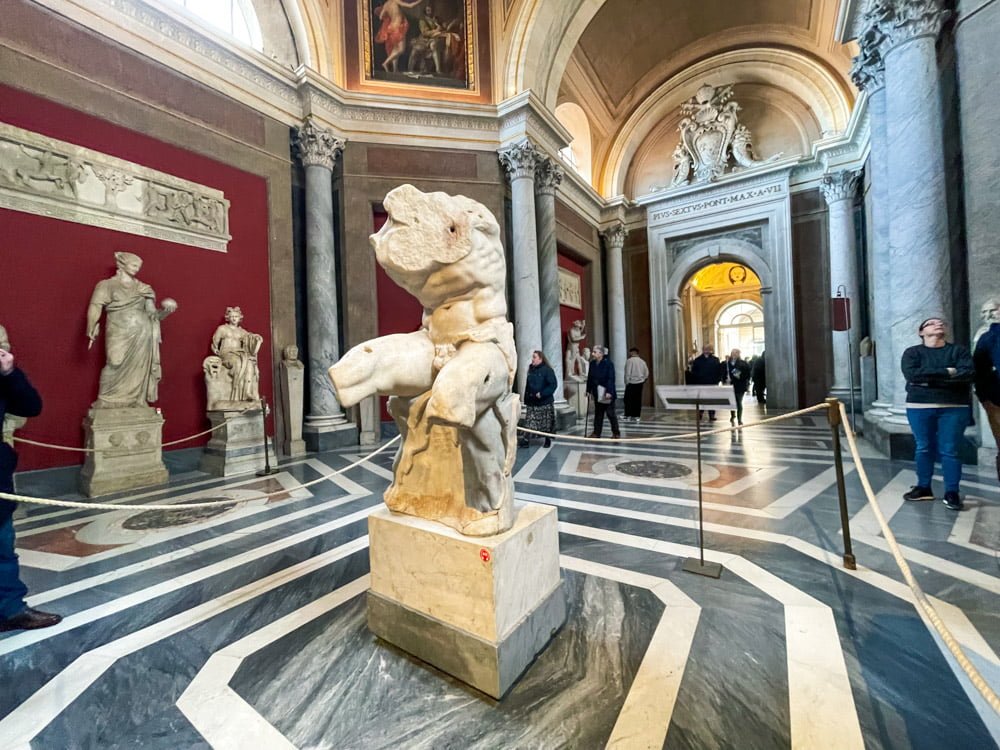
Papal Signatures in Art and Architecture
The Vatican used art to display its political clout from the beginning. In fact, you can see the papal symbols imprinted on various artworks and sculptures around the Vatican Museums and Rome. You can recognise these signatures belonging to papal families on fountains, frescoes, and floors throughout the Vatican Museums.
For instance, you can see in many places the Barberini family’s bees, one of the most influential and powerful Roman families during the Counter-Reformation and Baroque periods. Notably, three popes, Urban VIII, Innocent X, and Urban IX, belonged to the Barberini and served the Vatican.
The exhibits and architecture of the Vatican Museums feature various symbols of the Vatican, such as the tiara, the papal cross, and the keys of St. Peter. Each symbol has a specific interpretation and reflects the tradition and faith of the Catholic Church. The papal coat of arms was used to convey spiritual values and meanings and to express the temporal power of the Vatican as a true European political force.
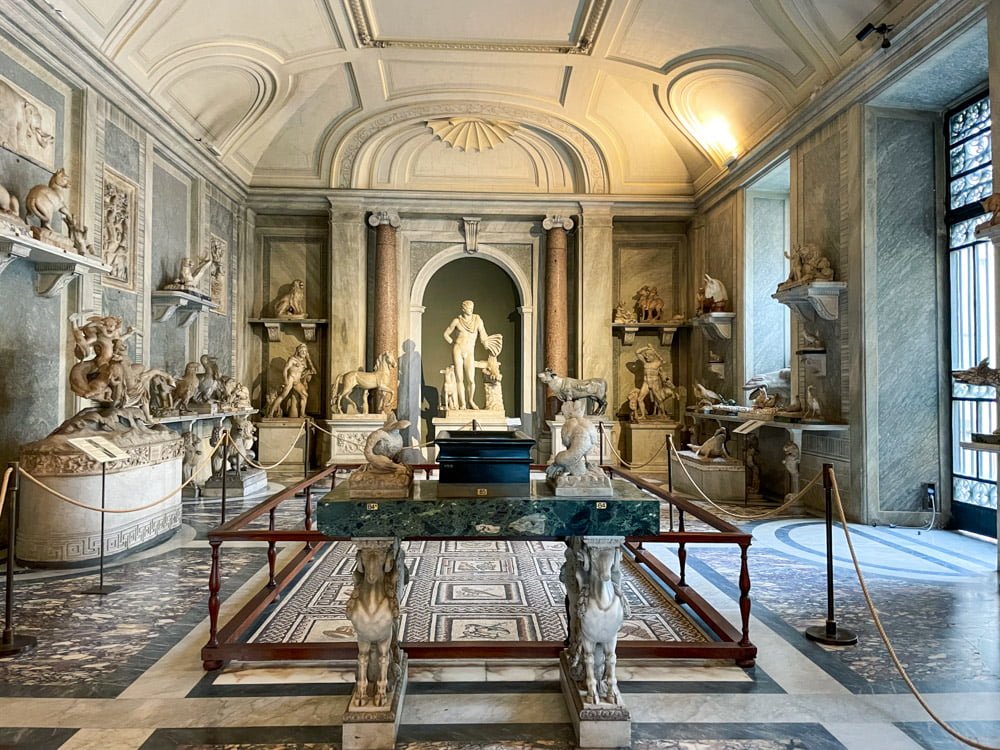
Practical Information for Visiting the Vatican Museums
The Vatican Museums are among the most famous museums in the world. However, there are some issues that you should be aware of that can affect your experience. One of the main issues is the possibility of crowds, especially on certain days or at particular times of the year.
In the summer and during festivities, the Vatican Museums receive a high influx of visitors. I highly recommend booking your tickets to avoid long queues. Once you have booked your tickets online, you can go directly to the ticket office to exchange your booking voucher for the tickets, with minimal waiting time.
It is essential to have a skip-the-line ticket to visit the Vatican Museums. If not, you will have to wait in a long queue around the Vatican walls, crowded even during the low season. Moreover, if you run out of admissions on the day of your visit, you may not be able to enter the Vatican Museums.
I could only see a little during my first visit due to the large crowds. So, I decided to go back during the off-season. However, many people crowd the most popular rooms, even during the off-season. It’s worth noting that groups allowed in the Vatican Museums can consist of up to 30 people, which can take up a lot of space in these rooms.
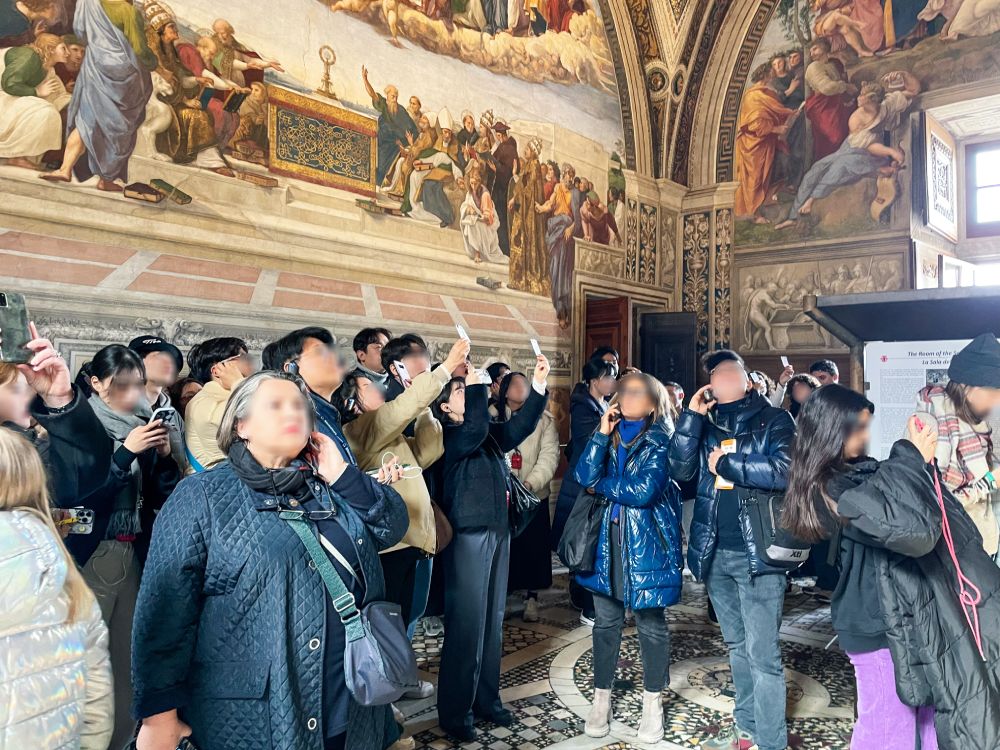
How to (Try to) Avoid Crowds and Queues
If you want to avoid waiting in line and being in a crowded space, booking skip-the-line tickets online in advance is best. You can book tickets for opening hours at 9 am or during evening hours to avoid the rush. Additionally, avoiding Vatican Museums during the summer with more tourists is a good idea.
It’s best to avoid visiting the Vatican Museums in large groups. Following the guide’s explanations with 30 people is almost impossible, especially in the smaller spaces. Instead, buy skip-the-line tickets and book a private tour with a licensed guide. This way, you can enjoy the museum at your own pace and get a more personalised experience. I followed this approach, and it worked out great for me.
To fully appreciate the beauty of the Vatican Museums, it’s advisable to have a customised guide based on your interests and preferences. The museums are extensive; you need proper guidance to avoid losing or wandering between collections and rooms.
How Much Do Tickets for the Vatican Museums Cost
The Vatican Museums are expensive, which makes it difficult for some visitors to afford. Online tickets cost €22, and if you opt for skip-the-line tickets (highly recommended), you should factor in a few extra euros for booking fees. Children and young people aged 6 to 18 are eligible for a reduced entrance fee of €13, while children under 5 years old can enter for free. However, as explained below, bringing young children to the Vatican Museums may not be a good idea.
Vatican Museums: How Much Time to Plan for the Visit
The Vatican Museums are incredibly vast, and it can take considerable time to explore everything. Visitors should plan to spend at least 3-4 hours in the museum to appreciate the breathtaking works of art on display fully. Some visitors may feel overwhelmed by the sheer volume of artwork, but taking the time to explore the museum at a comfortable pace is well worth the effort.
The Vatican Museums exhibit paintings, frescoes, tapestries, and sculptures rich in symbolism and hidden meanings. To fully appreciate these works of art, one needs to understand classical and Italian art history and culture deeply. Private guided tours, which last at least two hours, can help visitors gain such knowledge. After the tour, visitors are free to explore the Vatican Museums independently.
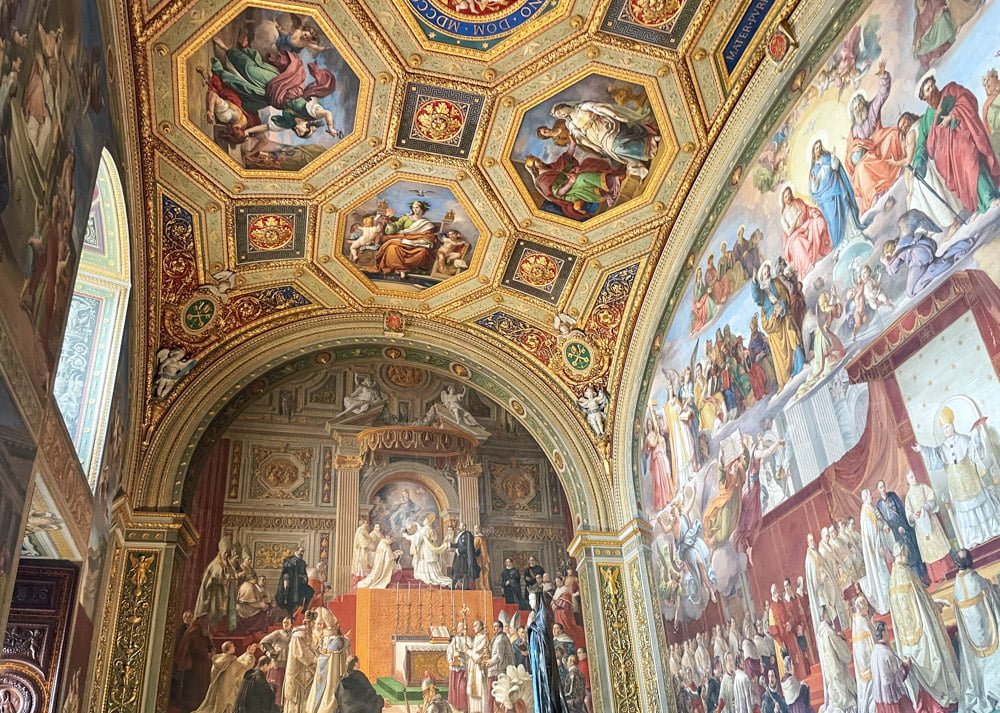
Accessibility of the Vatican Museums
Right now, accessibility is a significant issue for the Vatican Museums. The complex is large and has a complicated structure, making it challenging for visitors with disabilities or limited mobility to navigate. The main problem is that only visitors in wheelchairs, accompanied by one person and a guide, can use the lifts in the Vatican Museums. Additionally, the accessible route often leads in the opposite direction to the walking route, making it even more inconvenient for visitors.
Visiting the place may pose challenges for disabled tourists. For instance, they may need to split from their group to use the lifts. Or, if they have limited mobility but are not in a wheelchair, they won’t be able to use the lifts on the accessible route. In such cases, you should consult your guide and discuss the best and easiest route before starting the visit.
Vatican Museums with Kids: What You Need to Know Before You Go
Although I usually travel with my son, I visited the Vatican Museums solo. During my visit, I realised avoiding taking kids to the Vatican Museums may be better. The museums are vast, filled with ancient art, and not designed for toddlers. It can be overwhelming for children to visit crowded places like the Vatican Museums, where they cannot touch anything. I noticed several exhausted children during my visit.
I also do not recommend bringing very young children along because only wheelchairs can use the lifts. Strollers or pushchairs cannot use the lifts. The visit route has several points with stairs, particularly in the final passages towards the Sistine Chapel. So, you’ll need to carry your pram or pushchair down the stairs. This can be a tiring activity.
Travelling as a family is a beautiful experience, but you must be realistic. Other activities in Rome could be more suitable for children. However, with the help of a guide, children around the age of 10 and interested in art can appreciate the magnificent works in the Vatican Museums.
Opening and Closing Hours
The Vatican Museums are open Monday to Saturday from 9:00 am to 6:00 pm, with last admission at 4:00 pm. During the summer period on Fridays and Saturdays they are open until 10:30 pm, with last admission at 8:30 pm.
The closing day is Sunday, except on the last Sunday of the month, which are open in the morning with free admission (but can be even more crowded than usual). During holiday periods, Christmas and Easter in particular, the Vatican Museums may have different opening and closing times. I always advise you to check before booking your trip.
From the calendar below you can see the opening days and the availability of online skip-the-line tickets (be careful, they sell out easily). Just scroll down to the date of your trip and you can book by clicking on it.
How to Get to the Vatican Museums
If you’re looking for the Vatican Museums, you can find them within the walls of Vatican City, an independent state within Rome. The Vatican is relatively small and surrounded by walls, so you won’t find specific addresses like Via or Piazza. Search for “Vatican Museums” on Google Maps to find the right entry point.
The closest metro stations to the Vatican Museums are Cipro and Ottaviano, both on line A. The museum is just a ten-minute walk from either of these stations. Alternatively, you can take city bus 49 or 492 and get off at the Risorgimento/San Pietro stop. However, due to heavy traffic in Rome, I recommend to walk or take the metro whenever possible.
To help you visualise, the entrance to the Vatican Museums is located on the side walls. The longest queue, which usually extends beyond the boundaries of Vatican City, is for those without a reserved ticket. If you have a skip-the-line ticket, you can bypass the queue by walking on the street and showing your reservation to the staff outside the Vatican Museums. They will then let you into the ticket office without waiting in line.
Musei Vaticani
00120 Città del Vaticano
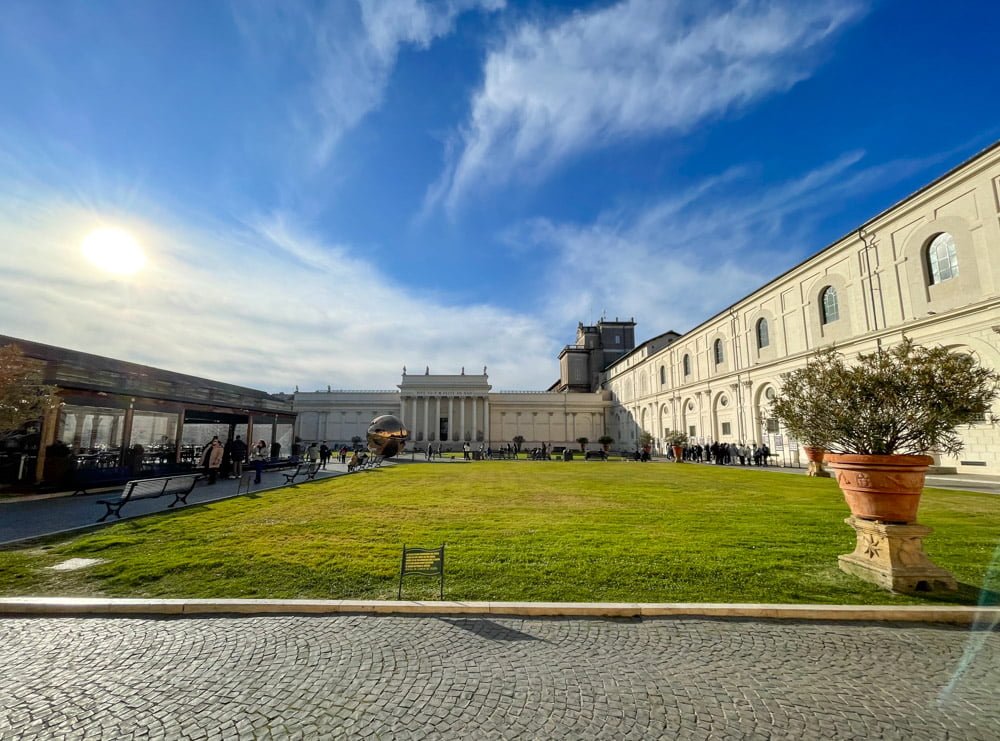
Are the Vatican Museums Worth Visiting?
To sum up, the Vatican Museums represent an invaluable art and culture collection. Despite some downsides, like overcrowding, limited accessibility, and expensive tickets, visiting the Vatican Museums is an unforgettable experience for anyone passionate about art and history.
If you plan your visit to the Vatican Museums well, you can fully immerse yourself in the beauty and greatness of Italian and world art. In my experience, having a guide, made a significant difference during my visit. If you have already visited the Vatican Museums, let me know if this post helped plan your next trip.
